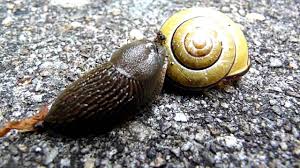Snails are the only molluscs (Mollusca) who also live on the land.
Snails and slugs grate with their tongue (radula) mainly algae and vegetable waste. Sometimes garden plants, preferably with a soft leaf as lettuce. They go preferably on the evening and overnight out for dinner. The humidity is high and it is cooler. During the day they appear sometimes during and after rain showers.
 Snails do not like dry and warm. Their shelters you can find where shade and moisture are: under pots, bricks, tiles, fallen leaves. There you can collect them and give them to the chickens. So you can use a fallen rhubarb leaf on the ground as trap. Or a plate of (sweet) beer, where they drown. You can also leave it to catch them by a hedgehog, a frog or toad. If a garden bed is harvested you can also put chicken(s) on it. Or unsurpassed efficiency: a duck. And delicious!
Snails do not like dry and warm. Their shelters you can find where shade and moisture are: under pots, bricks, tiles, fallen leaves. There you can collect them and give them to the chickens. So you can use a fallen rhubarb leaf on the ground as trap. Or a plate of (sweet) beer, where they drown. You can also leave it to catch them by a hedgehog, a frog or toad. If a garden bed is harvested you can also put chicken(s) on it. Or unsurpassed efficiency: a duck. And delicious!
Cutting surfaces such as eggshells, ashes, sand etc. don’t stop snails. A snail crawls partly thanks to its slime smoothly over the edge of a razor.
Snails avoid garlic (extract). Copper (band) would help (like for ants). Coffee dregs also, only temporarily. But how many kilograms do you need?
If you poison them (with grains from the market), you do it indirectly also with eaters (birds...)
Snails can be biologically controlled with nematodes. Here is a method by which you could cultivate or encourage them yourself.
Put in a bucket a layer of rain water (not tap water). Not too much, the snails should not drown. Add a layer of fresh young leaves which the slugs love, and lots of snails. Close the bucket so they cannot escape. Stir a little every day for 2 weeks. The nematodes will breed faster than the snails and do their job. After two weeks you have your own nematode culture.
Pour the water with the nematodes on crops which suffer from snails. The soil should be moist (and remain) otherwise you can dehydrate the culture. Repeat regularly. And do not forget the compost heap.
For your favorite snacks like strawberries or lettuce can snails also be outwitted by breeding them (the snacks, not the snails) in hanging baskets.
Snails use about 40 percent of their energy to produce mucus. Through smart following another track they are doing to slipstreaming (or mucus streaming) and consume less. They are slow, but can take more than one meter per hour. The Burgundy snail, Roman snail, edible snail or escargot (Helix pomatia) can race up to 4.8 (and champions a bit more) m / h. (m: meters, not miles.)
"Waiter, there's a snail on my plate!" "Then we will have to charge a little more sir!"
The snail reached the ark through perseverance.
